Architecture
Introduction
The goal of the new northbound API is to provide a better interface to configure and monitor FRR programatically. The current design based on CLI commands is no longer adequate in a world where computer networks are becoming increasingly bigger, more diverse and more complex. Network scripting using expect and screen scraping techniques is too primitive and unreliable to be used in large-scale networks. What is proposed is to modernize FRR to turn it into an API-first routing stack, and reposition the CLI on top of this API. The most important change, however, is not the API that will be provided to external users. In fact, multiple APIs will be supported and users will have the ability to write custom management APIs if necessary. The biggest change is the introduction of a model-driven management architecture based on the YANG modeling language. Instead of writing code tied to any particular user interface (e.g. DEFUNs), YANG allows us to write API-agnostic code (in the form of callbacks) that can be used by any management interface. As an example, it shouldn’t matter if a set of configuration changes is coming from a NETCONF session or from a CLI terminal, the same callbacks should be called to process the configuration changes regardless of where they came from. This model-driven design ensures feature parity across all management interfaces supported by FRR.
Quoting RFC 7950:
YANG is a language originally designed to model data for the NETCONF protocol. A YANG module defines hierarchies of data that can be used for NETCONF-based operations, including configuration, state data, RPCs, and notifications. This allows a complete description of all data sent between a NETCONF client and server. Although out of scope for this specification, YANG can also be used with protocols other than NETCONF.
While the YANG and NETCONF specifications are tightly coupled with one another, both are independent to a certain extent and are evolving separately. Examples of other management protocols that use YANG include RESTCONF, gNMI and CoAP.
In addition to being management-protocol independent, some other advantages of using YANG in FRR are listed below:
Have a formal contract between FRR and application developers (management clients). A management client that has access to the FRR YANG models knows about all existing configuration options available for use. This information can be used to auto-generate user-friendly interfaces like Web-UIs, custom CLIs and even code bindings for several different programming languages. Using PyangBind, for example, it’s possible to generate Python class hierarchies from YANG models and use these classes to instantiate objects that mirror the structure of the YANG modules and can be serialized/deserialized using different encoding formats.
Support different encoding formats for instance data. Currently only JSON and XML are supported, but GPB and CBOR are other viable options in the long term. Additional encoding formats can be implemented in the libyang library for optimal performance, or externally by translating data to/from one of the supported formats (with a performance penalty).
Have a formal mechanism to introduce backward-incompatible changes based on semantic versioning (not part of the YANG standard, which allows backward-compatible module updates only).
Provide seamless support to the industry-standard NETCONF/RESTCONF protocols as alternative management APIs. If FRR configuration/state data is modeled using YANG, supporting YANG-based protocols like NETCONF and RESTCONF is much easier.
As important as shifting to a model-driven management paradigm, the new
northbound architecture also introduces the concept of configuration
transactions. Configuration transactions allow management clients to
commit multiple configuration changes at the same time and rest assured
that either all changes will be applied or none will (all-or-nothing).
Configuration transactions are implemented as pseudo-atomic operations
and facilitate automation by removing the burden of error recovery from
the management side. Another property of configuration transactions is
that the configuration changes are always processed in a pre-defined
order to ensure consistency. Configuration transactions that encompass
multiple network devices are called network-wide transactions and are
also supported by the new northbound architecture. When FRR is built
using the --enable-config-rollbacks option, all committed
transactions are recorded in the FRR rollback log, which can reside
either in memory (volatile) or on persistent storage.
Network-wide Transactions is the most important leap in network management technology since SNMP. The error recovery and sequencing tasks are removed from the manager side. This is usually more than half the cost in a mature system; more than the entire cost of the managed devices. [source].
Figures 1 and 2 below illustrate the old and new northbound architecture of FRR, respectively. As it can be seen, in the old architecture the CLI was the only interface used to configure and monitor FRR (the SNMP plugin was’t taken into account given the small number of implemented MIBs). This means that the only way to automate FRR was by writing scripts that send CLI commands and parse the text output (which usually doesn’t have any structure) using screen scraping and regular expressions.
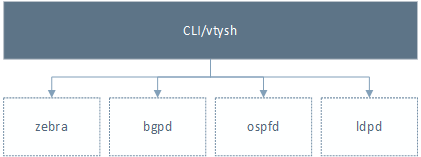
Old northbound architecture
The new northbound architectures, on the other hand, features a multitude of different management APIs, all of them connected to the northbound layer of the FRR daemons. By default, only the CLI interface is compiled built-in in the FRR daemons. The other management interfaces are provided as optional plugins and need to be loaded during the daemon initialization (e.g. zebra -M grpc). This design makes it possible to integrate FRR with different NETCONF solutions without introducing vendor lock-in. The [[Plugins - Writing Your Own]] page explains how to write custom northbound plugins that can be tailored to all needs (e.g. support custom transport protocols, different data encoding formats, fine-grained access control, etc).
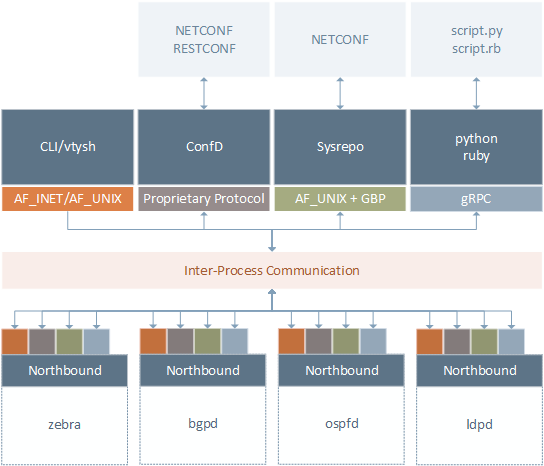
New northbound architecture
Figure 3 shows the internal view of the FRR northbound architecture. In this image we can see that northbound layer is an abstract entity positioned between the northbound callbacks and the northbound clients. The northbound layer is responsible to process the requests coming from the northbound clients and call the appropriate callbacks to satisfy these requests. The northbound plugins communicate with the northbound layer through a public API, which allow users to write third-party plugins that can be maintained separately. The northbound plugins, in turn, have their own APIs to communicate with external management clients.
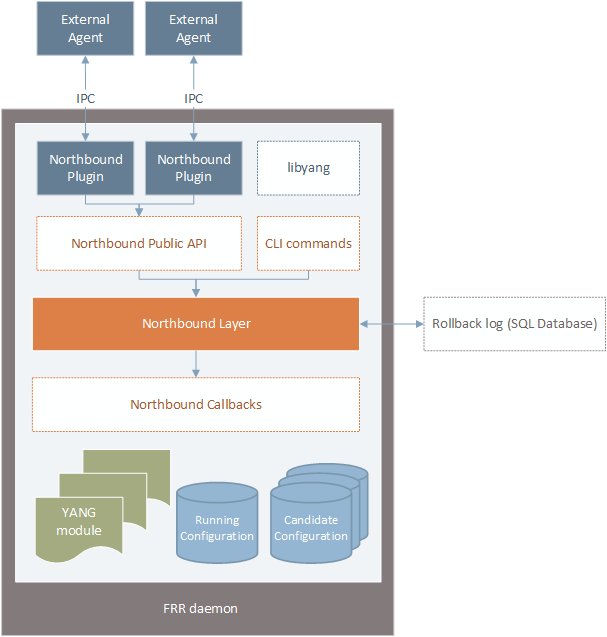
New northbound architecture - internal view
Initially the CLI (and all of its commands) will be maintained inside the FRR daemons. In the long term, however, the goal is to move the CLI to a separate program just like any other management client. The [[Advanced Topics]] page describes the motivations and challenges of doing that. Last but not least, the libyang block inside the northbound layer is the engine that makes everything possible. The libyang library will be described in more detail in the following sections.
YANG models
The main decision to be made when using YANG is which models to implement. There’s a general consensus that using standard models is preferable over using custom (native) models. The reasoning is that applications based on standard models can be reused for all network appliances that support those models, whereas the same doesn’t apply for applications written based on custom models.
That said, there are multiple standards bodies publishing YANG models and unfortunately not all of them are converging (or at least not yet). In the context of FRR, which is a routing stack, the two sets of YANG models that would make sense to implement are the ones from IETF and from the OpenConfig working group. The question that arises is: which one of them should we commit to? Or should we try to support both somehow, at the cost of extra development efforts?
Another problem, from an implementation point of view, is that it’s
challenging to adapt the existing code base to match standard models. A
more reasonable solution, at least in a first moment, would be to use
YANG deviations and augmentations to do the opposite: adapt the standard
models to the existing code. In practice however this is not as simple
as it seems. There are cases where the differences are too substantial
to be worked around without restructuring the code by changing its data
structures and their relationships. As an example, the ietf-rip model
places per-interface RIP configuration parameters inside the
control-plane-protocol list (which is augmented by ietf-rip). This
means that it’s impossible to configure RIP interface parameters without
first configuring a RIP routing instance. The ripd daemon on the other
hand allows the operator to configure RIP interface parameters even if
router rip is not configured. If we were to implement the ietf-rip
module natively, we’d need to change ripd’s CLI commands (and the
associated code) to reflect the new configuration hierarchy.
Taking into account that FRR has a huge code base and that the northbound retrofitting process per-se will cause a lot of impact, it was decided to take a conservative approach and write custom YANG models for FRR modeled after the existing CLI commands. Having YANG models that closely mirror the CLI commands will allow the FRR developers to retrofit the code base much more easily, without introducing backward-incompatible changes in the CLI and reducing the likelihood of introducing bugs. The [[Retrofitting Configuration Commands]] page explains in detail how to convert configuration commands to the new northbound model.
Even though having native YANG models is not the ideal solution, it will be already a big step forward for FRR to migrate to a model-driven management architecture, with support for configuration transactions and multiple management interfaces, including NETCONF and RESTCONF (through the northbound plugins).
The new northbound also features an experimental YANG module translator that will allow users to translate to and from standard YANG models by using translation tables. The [[YANG module translator]] page describes this mechanism in more detail. At this point it’s unclear what can be achieved through module translation and if that can be considered as a definitive solution to support standard models or not.
Northbound Architecture
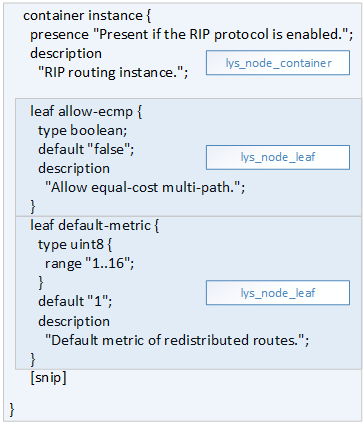
libyang's lys_node data structure

libyang's lyd_node data structure
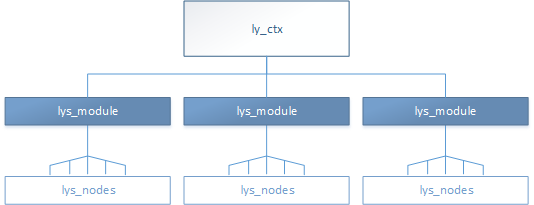
libyang's ly_ctx data structure

Configuration transactions
Testing
The new northbound adds the libyang library as a new mandatory dependency for FRR. To obtain and install this library, follow the steps below:
git clone https://github.com/CESNET/libyang
cd libyang
git checkout devel
mkdir build ; cd build
cmake -DENABLE_LYD_PRIV=ON ..
make
sudo make install
Note
first make sure to install the libyang requirements.
FRR needs libyang from version 0.16.7 or newer, which is maintained in
the devel branch. libyang 0.15.x is maintained in the master
branch and doesn’t contain one small feature used by FRR (the
LY_CTX_DISABLE_SEARCHDIR_CWD flag). FRR also makes use of the
libyang’s ENABLE_LYD_PRIV feature, which is disabled by default and
needs to be enabled at compile time.
It’s advisable (but not required) to install sqlite3 and build FRR with
--enable-config-rollbacks in order to have access to the
configuration rollback feature.
To test the northbound, the suggested method is to use the
[[Transactional CLI]] with the ripd daemon and play with the new
commands. The debug northbound command can be used to see which
northbound callbacks are called in response to the commit command.
For reference, the [[Demos]] page shows a small demonstration of the
transactional CLI in action and what it’s capable of.